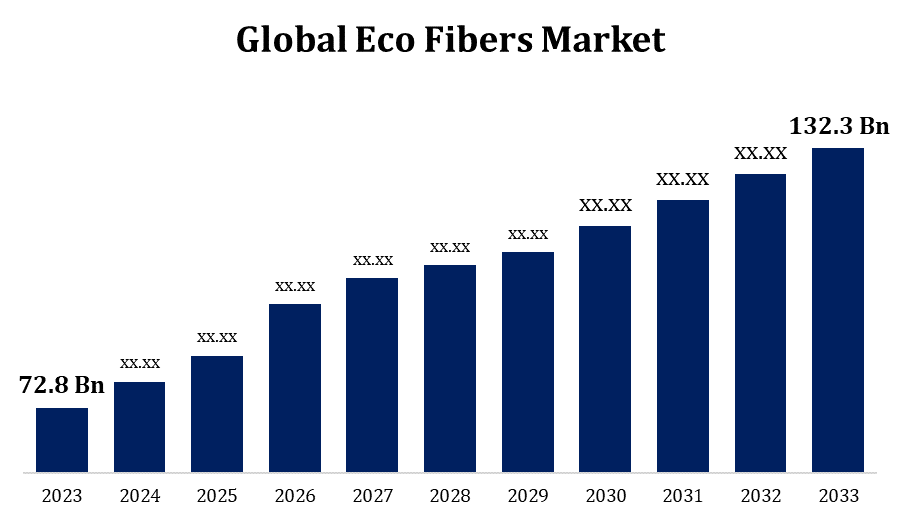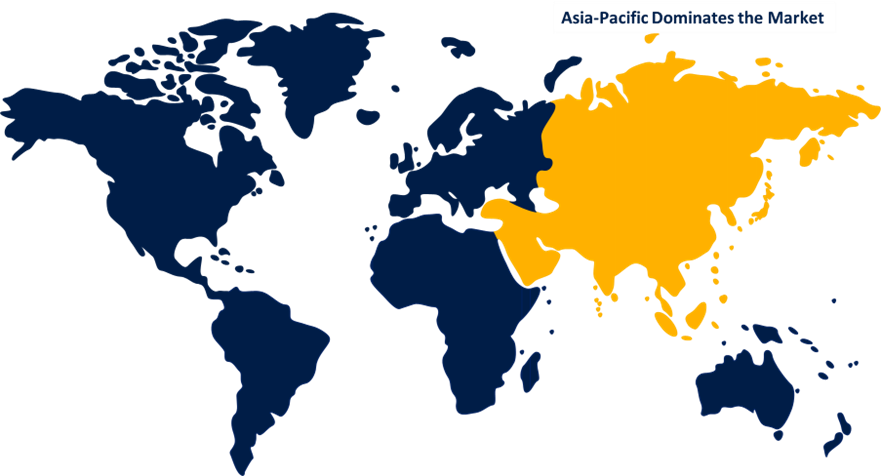Global Eco Fibers Market Size, Share, and COVID-19 Impact Analysis, By Type (Regenerated fibers, Recycled fibers, Organic fibers), By Application (Textile/Clothing, Household Furnishings, Industrial, Medical), and By Region (North America, Europe, Asia-Pacific, Latin America, Middle East, and Africa), Analysis and Forecast 2022 - 2032
Industry: Advanced MaterialsGlobal Eco Fibers Market Insights Forecasts to 2032
- The Global Eco Fibers Market Size was valued at USD 46.22 Billion in 2022.
- The Market is growing at a CAGR of 7.8% from 2022 to 2032
- The Worldwide Eco Fibers Market Size is expected to reach USD 98.19 Billion by 2032
- North America is expected to grow the fastest during the forecast period

Get more details on this report -
The Global Eco Fibers Market size is anticipated to exceed USD 98.19 Billion by 2032, growing at a CAGR of 7.8% from 2022 to 2032.
The increasing acceptance of organic cotton is projected to propel the market. Businesses increasingly favor organic cotton because it does not pollute surface water, soil, or air. Furthermore, growing concern about the negative environmental impacts of synthetic fibers has been an important driver contributing to the increased demand for organic eco fiber in recent years.
Market Overview
The term "Eco Fiber" refers to a thin, long, flexible thread-like structure derived from animals, plants, or minerals. Eco fibers are a renewable source with numerous advantages, including high specific stiffness and strength, a desirable fiber aspect ratio, and easy availability from natural sources. Bamboo, sisal, cotton, and jute are examples of common eco fibers derived from plants. Eco fibers are an essential component of clothing/textile applications. They are also known as sustainable fibers because they include natural, regenerated, and recycled fibers. These fiber materials have similar properties to synthetic fibers, but eco fibers are more environmentally friendly in both manufacturing and use. Organic fibers refer to those that are produced and grown in an environment-friendly manner. The crop is grown without the utilization of chemical-based pesticides, insecticides, or fertilizers, and then turned into fiber or yarn with energy efficiency and minimal environmental impact. Regenerated fibers are made from cellulose, which is primarily obtained from wood pulp. The demand for eco-friendly fibers from sectors including textile/clothing, household furnishings, and industrial is driving the eco fibers market.
Report Coverage
This research report categorizes the market for the global eco fibers market based on various segments and regions and forecasts revenue growth and analyzes trends in each submarket. The report analyses the key growth drivers, opportunities, and challenges influencing the eco fibers market. Recent market developments and competitive strategies such as expansion, product launch, and development, partnership, merger, and acquisition have been included to draw the competitive landscape in the market. The report strategically identifies and profiles the key market players and analyses their core competencies in each sub-segment of the eco fibers market.
Global Eco Fibers Market Report Coverage
| Report Coverage | Details |
|---|---|
| Base Year: | 2022 |
| Market Size in 2022: | USD 46.22 Billion |
| Forecast Period: | 2022-2032 |
| Forecast Period CAGR 2022-2032 : | 7.8% |
| 2032 Value Projection: | USD 98.19 Billion |
| Historical Data for: | 2018-2021 |
| No. of Pages: | 240 |
| Tables, Charts & Figures: | 130 |
| Segments covered: | By Type, By Application, By Region, and COVID-19 Impact Analysis |
| Companies covered:: | Sateri, Lenzing AG, Universal Fibers Inc., Aditya Birla Management Corporation Pvt. Ltd, Grasim Industries Ltd., Tangshan Sanyou Group Xingda Chemical Fibre Co., Ltd., US Fibers, Teijin Limited., Polyfiber Industries Limited, David C Poole Company Inc., Wellman Advanced Materials, Shanghai Tenbro Bamboo Textile Co. Ltd., China Bambro Textile (Group) Co., Ltd., Pilipinas Ecofiber Corporation, Foss Performance Materials, and Others |
| Pitfalls & Challenges: | COVID-19 has the potential to impact the global market |
Get more details on this report -
Driving Factors
The fashion industry is expanding rapidly as the textile/apparel, automotive, and medical industries expand. The expansion of these industries is driving up demand for these eco fibers. Increasing economies like China, India, South Africa, and Southeast Asia are propelling the eco fiber market. Due to these developing countries' high disposable income, demand for household items and apparel is increasing. Furthermore, population growth increases consumer demand for more housing, automobiles, and clothing. As a result, the increasing use of fabric for various applications including furnishing, covering, and interior design will boost product demand. Furthermore, the pandemic compelled developing nations to employ Eco Fiber in medical applications. The factors driving the market growth are meeting consumer demand during the pandemic, reducing the chances of infection, and maintaining personal hygiene. Because of environmental concerns and stringent government regulations requiring manufacturing firms to reduce GHG emissions during the manufacturing process, the global textile and apparel industries have seen an increase in demand for cellulosic fiber.
Restraining Factors
The availability of inexpensive substitutes that include nylon, polyester, and cotton made with inexpensive methods makes the final product affordable to the majority of end users and the local population. The product's farming and manufacturing are both expensive, raising the overall cost of Eco Fiber. Furthermore, substitutes for synthetic fibers such as polyester, rayon, and nylon have affordable costs and are easily accessible to customers, resulting in a greater shift towards synthetic fibers. Furthermore, synthetic fibers are simple to produce, process, and use in numerous industries, which influences fiber consumption. All of these factors are limiting the eco fiber market growth.
Market Segmentation
The Global Eco Fibers Market share is classified into type and application.
- The regenerated fibers segment is expected to grow at the fastest pace in the global eco fibers market during the forecast period.
The global eco fibers market is categorized by type into regenerated fibers, recycled fibers, and organic fibers. Among these, the regenerated fibers segment is expected to grow at the fastest pace in the global eco fibers market during the forecast period. The growth can be attributed to rising consumer demand for environmental-friendly products that promote sustainability. Regenerated cellulosic fiber has excellent characteristics that make it a perfect replacement for synthetic fibers, such as high wet tenacity, good absorbing capacity, softness, shine, ease of the process of dyeing, biodegradable properties, and good drape.
- The textile segment accounted for the largest share of the global eco fibers market in 2022.
Based on the application, the global eco fibers market is divided into textile/clothing, household furnishings, industrial, and medical. Among these, the textile segment accounted for the largest share of the global eco fibers market in 2022. The increase can be attributed to the rapidly increasing demand for clothing/garments around the world. Eco fibers are used in a variety of apparel products, including shirts, jackets, and children's clothing, as well as bed sheets, pillow covers, luggage, sacks, landfill coverings, and healthcare textiles. During the projected period, the textile industry is anticipated to see an upsurge in demand for casual apparel, formal wear, and stylish apparel among all age groups. Fabrics such as lycra, denim, silk, cotton, and polyester are widely used in the production of fashion textiles and clothing. Furthermore, the increasing use of luxury and trending fashionable clothing, particularly among the youth and adult population, is a significant driving factor for the market.
Regional Segment Analysis of the Global Eco Fibers Market
- North America (U.S., Canada, Mexico)
- Europe (Germany, France, U.K., Italy, Spain, Rest of Europe)
- Asia-Pacific (China, Japan, India, Rest of APAC)
- South America (Brazil and the Rest of South America)
- The Middle East and Africa (UAE, South Africa, Rest of MEA)
Asia Pacific dominated the largest share of the global eco fibers market in 2022.

Get more details on this report -
Asia Pacific holds the largest share of the global eco fibers market. Over the forecast period, the eco fiber market is projected to expand due to rising demand for clothes and increased demand for sustainable textiles. This scenario is likely to be shown in major economies such as India, China, Japan, and Australia in the coming years. India is the most rapidly expanding market in Asia Pacific, due to the country's rising population, rising per capita apparel consumption, and expanding foreign investment, among other major economic factors that are likely driving market growth. The increasing utilization of polyester, acrylic fibers, and viscose for household, technical, and clothing applications, on the other hand, is projected to stifle the growth of eco fibers across the region. Furthermore, the growing use of handbags, clothing accessories, and apparel is projected to boost demand for textiles in fashion and clothing applications in the coming years.
North America is expected to grow at the fastest pace in the global eco fibers market during the forecast period. Demand for eco fibers is increasing in final-use sectors that include textiles, industrial, medical textiles, packaging, and household. Furthermore, a growing elderly population and initiatives to develop superior sports apparel will likely contribute to regional market growth over the forecast period. Furthermore, factors such as growing sustainable practices as a result of increased environmental awareness are driving eco fiber growth across the region.
Competitive Analysis:
The report offers the appropriate analysis of the key organizations/companies involved within the global eco fibers along with a comparative evaluation primarily based on their product offering, business overviews, geographic presence, enterprise strategies, segment market share, and SWOT analysis. The report also provides an elaborative analysis focusing on the current news and developments of the companies, which includes product development, innovations, joint ventures, partnerships, mergers & acquisitions, strategic alliances, and others. This allows for the evaluation of the overall competition within the market.
List of Key Companies
- Sateri
- Lenzing AG
- Universal Fibers Inc.
- Aditya Birla Management Corporation Pvt. Ltd
- Grasim Industries Ltd.
- Tangshan Sanyou Group Xingda Chemical Fibre Co., Ltd.
- US Fibers
- Teijin Limited.
- Polyfiber Industries Limited
- David C Poole Company Inc.
- Wellman Advanced Materials
- Shanghai Tenbro Bamboo Textile Co. Ltd.
- China Bambro Textile (Group) Co., Ltd.
- Pilipinas Ecofiber Corporation
- Foss Performance Materials
- Others
Key Target Audience
- Market Players
- Investors
- End-users
- Government Authorities
- Consulting And Research Firm
- Venture capitalists
- Value-Added Resellers (VARs)
Recent Developments
- In April 2022, Teijin LTD. has developed a high-performance eco-friendly staple polyester nanofiber to reinforce rubber in products such as vehicle tires, hoses, and belts.
- In December 2022, The Lenzing Group and Renewcell, the Swedish pioneer in textile-to-textile recycling, have signed a multi-year supply agreement to accelerate the textile industry's transition from a linear to a circular business model.
- In April 2023, Lenzing Group, the world's largest manufacturer of wood-based specialty fibers, disclosed the launch of carbon neutral VEOCEL branded viscose fibers for Europe and the United States, expanding its global sustainable viscose fiber portfolio.
Market Segment
This study forecasts revenue at global, regional, and country levels from 2020 to 2032. Spherical Insights has segmented the Global Eco Fibers Market based on the below-mentioned segments:
Global Eco Fibers Market, By Type
- Regenerated fibers
- Recycled fibers
- Organic fibers
- Others
Global Eco Fibers Market, By Application
- Textile/Clothing
- Household Furnishings
- Industrial
- Medical
- Others
Global Eco Fibers Market, By Region
- North America
- US
- Canada
- Mexico
- Europe
- Germany
- Uk
- France
- Italy
- Spain
- Russia
- Rest of Europe
- Asia Pacific
- China
- Japan
- India
- South Korea
- Australia
- Rest of Asia Pacific
- South America
- Brazil
- Argentina
- Rest of South America
- Middle East & Africa
- UAE
- Saudi Arabia
- Qatar
- South Africa
- Rest of Middle East & Africa
Need help to buy this report?